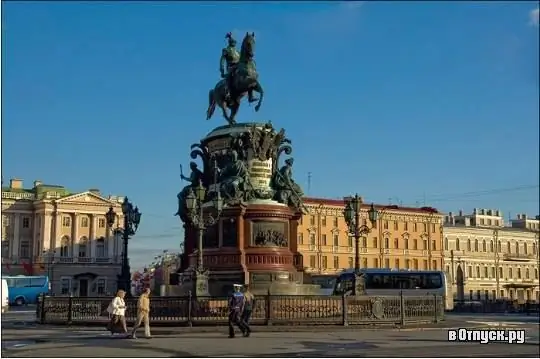
Description of the attraction
The monument to Nicholas I was erected in St. Petersburg on St. Isaac's Square at the behest of the son of Nicholas I - Alexander II. It is located on the site between St. Isaac's Cathedral and the Mariinsky Palace. It is on the same axis with the Bronze Horseman, the majestic Isaac separates the two royal horsemen, this was immediately noticed by the Petersburg witches. Tradition says that after the opening of the monument, a plaque appeared on it with the inscription: "You will not catch up!" And the proverb went around the city: "Kolya is catching up with Petya, but Isaac is interfering" or its more popular version: "The clever fool is catching up, but Isaac is interfering."
The monument to Nicholas the First is the only equestrian statue at the time of its creation, which had only two points of support - the hooves of a prancing horse. The stability of such a structure was not easy to calculate. Was this task accomplished by the famous sculptor who created the monument? Peter Karlovich Klodt. To ensure the stability of the monument, several pounds of shot were poured into the horse's croup, and iron racks were brought under the hooves of the horse's hind legs, stretching to the base of the monument.
The monument was designed by Auguste Montferrand in 1856-1859. The monument helped the famous architect to combine all the buildings of St. Isaac's Square into a complete ensemble. The sculpture of Nicholas I was created by P. K. Klodt.
Initially, Klodt was asked to perform the figure of a rider on a stationary horse. But such a sketch did not satisfy Montferrand. Then the sculptor decided to depict a prancing horse striving upward with an immobile rider. It was this idea that Klodt embodied.
The production of the monument, as well as the calculation of its construction, was rather complicated. When Alexander II examined the sculpture in the workshop, he ordered certain changes to be made, such as reducing the visor of the helmet, changing the horse's left gait to the right gait, etc. Which was done by the sculptor. The sculpture was supposed to be cast in April 1858. But the mold could not stand the bronze melt. Fortunately, Emperor Alexander III paid for the continuation of the work and the manufacture of a new, more durable form. The second attempt to cast the statue was successful.
The sculpture is an equestrian statue of Nicholas I, 6 m high. The sculptor depicted the Emperor in the ceremonial uniform of the Life Guards Horse Regiment. The pedestal of the monument is also a work of sculptural art. The pedestal was made by architects A. Poirot and N. Efimov. It is decorated with allegorical figures of Power, Wisdom, Faith, Justice, depicted in the form of female figures, made by R. K. Zaleman. Their faces are exact copies of the faces of the wife of Nicholas I and his three daughters: Maria, Olga and Alexandra. In addition, high reliefs are made on the pedestal, depicting the main events that took place in the country during the reign of the emperor: the uprising of the Decembrists, suppression of the cholera revolt, awarding M. M. Speransky. for the collection and publication of the first set of Russian laws and the opening of the Verebinsky railway bridge. Three high reliefs belong to the hand of N. A. Romazanov, one - R. K. Zaleman. Several types of marble are used in the facing of the pedestal, red Finnish and dark gray Serdobolsk granite, red Shoksha porphyry. The monument is surrounded by four lanterns that have every right to be called "the most beautiful lanterns of St. Petersburg".
The monument to Nicholas I was opened on July 25, 1859. some time after the death of the king. The reign of Nicholas I was not easy for the Russian Empire. The tsar was distinguished by a harsh disposition and ruled the country quite harshly, for which the people called him Nikolai Palkin. He was not loved and feared. Nicholas I carried out repressions, he introduced strict censorship, and in large cities there were secret intelligence agents at every corner, looking for the sovereign's enemies. Klodt portrayed Nicholas I in such a way as to convey the character of the emperor: he smugly and proudly sits on a rearing horse.
After the revolution of 1917, the question of dismantling the monument was repeatedly raised, but due to its uniqueness (the stability of the sculpture is ensured by only two support points), it was recognized as the greatest work of engineering, and the monument was not destroyed. In the 30s. XX century, only the fence of the monument was dismantled. It was recreated in 1992.






